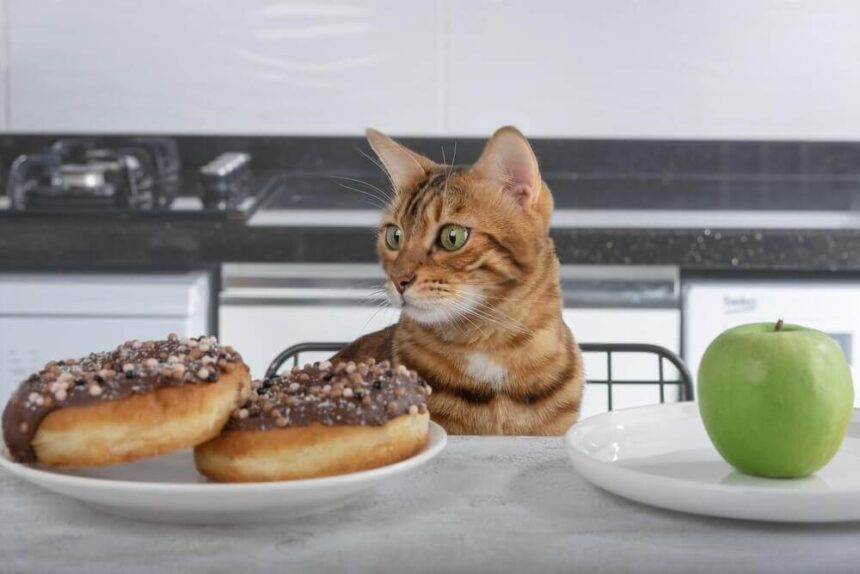Cats are known for their particular dietary needs and preferences, which often differ from those of humans. As a responsible cat owner, it’s essential to educate yourself about what foods are safe and appropriate for your feline companion. Icing, a popular topping used in many human desserts, raises questions about its suitability for cats. In this article, we will delve into the topic of whether cats can eat icing, exploring the potential risks, considerations, and alternative options for treating your beloved feline friend.
Understanding a Cat’s Nutritional Needs
Before we discuss the specifics of icing, it is crucial to understand the nutritional requirements of cats. As obligate carnivores, cats have evolved to thrive on a diet primarily composed of animal protein. They require specific nutrients such as taurine, arachidonic acid, and vitamin A, which are abundant in animal tissues. Additionally, cats lack certain digestive enzymes, such as amylase, which makes it challenging for them to break down carbohydrates efficiently.
Risks Associated with Icing Consumption
High Sugar Content
Icing typically contains a substantial amount of sugar, which is not a part of a cat’s natural diet. Cats lack the taste receptors necessary to perceive sweetness and do not require the same energy sources as humans. Feeding cats sugary foods like icing can lead to weight gain, obesity, and potentially diabetes.
Lactose Intolerance
Many icing recipes include dairy products like butter or milk, which may contain lactose. Most adult cats are lactose intolerant and lack the enzyme lactase, necessary to break down lactose. Feeding a lactose-intolerant cat icing with dairy-based ingredients could result in digestive upset, including diarrhea and stomach discomfort.
Artificial Ingredients
Some commercial icings contain artificial additives, including colorings, flavorings, and preservatives. These ingredients can be potentially harmful to cats, causing allergic reactions, gastrointestinal disturbances, or even toxicities.
Digestive Issues
Cats have sensitive digestive systems, and consuming large amounts of icing can disrupt their gut flora and lead to gastrointestinal upset. This can manifest as vomiting, diarrhea, or changes in appetite.
Alternatives to Icing for Cats
Cat-Friendly Treats
Rather than offering icing, there are numerous cat treats available on the market that are specifically formulated for feline consumption. These treats are designed to meet a cat’s nutritional needs and are often made with ingredients that are safe and beneficial for cats, such as high-quality animal protein.
Plain Cooked Meat
A safer and more natural alternative to icing is offering your cat small amounts of plain, cooked meat. Chicken, turkey, or fish (without seasoning) can be offered as an occasional treat. Remember to remove any bones and avoid using fatty or seasoned meats.
Commercial Cat Foods
A well-balanced, nutritionally complete cat food should be the primary component of your cat’s diet. High-quality cat foods are specially formulated to provide the necessary nutrients, vitamins, and minerals that cats need for optimal health. Treats and snacks should only make up a small portion of a cat’s overall diet.
FAQ’s
Can cats have a small amount of icing as an occasional treat?
While a small amount of icing may not immediately harm a cat, it is generally not recommended as an occasional treat. The high sugar content and potential for digestive issues make it a less suitable option for cats. It’s better to choose cat-friendly treats specifically formulated for feline consumption.
Are there any safe alternatives to icing that cats can enjoy?
Yes, there are several safe alternatives to icing that cats can enjoy. Some options include cat treats specifically designed for feline consumption, small amounts of plain cooked meat (such as chicken or turkey), or high-quality commercial cat foods. These options are more suitable for a cat’s dietary needs and are less likely to cause digestive issues or other health problems.
Can cats eat icing made with non-dairy ingredients?
While non-dairy icing may not contain lactose, it is still not an ideal treat for cats. The high sugar content and potential for artificial additives in icing can still pose health risks for cats. It’s best to stick to treats specifically formulated for feline consumption to ensure your cat’s nutritional needs are met.
Should I consult my veterinarian before giving my cat icing?
It is always a good idea to consult with your veterinarian before introducing any new food or treat into your cat’s diet. They can provide personalized advice based on your cat’s specific needs and health conditions. Your veterinarian can guide you on suitable treats and help ensure your cat’s overall diet is balanced and appropriate.
Are there any specific cat-friendly desserts or treats I can make at home?
There are several cat-friendly desserts and treats you can make at home that are safe and enjoyable for cats. Some options include homemade catnip treats, tuna or salmon-based treats, or baking small, plain meatballs for your cat. It’s important to use cat-safe ingredients and follow recipes designed specifically for feline consumption to ensure your cat’s health and safety.
Can kittens eat icing?
Kittens have even more specific dietary needs than adult cats, and their digestive systems are still developing. It is best to avoid feeding icing or any sugary treats to kittens. Kittens should primarily be fed a high-quality, nutritionally complete kitten food that meets their specific requirements for growth and development. Consult your veterinarian for guidance on appropriate treats for kittens.
What should I do if my cat accidentally consumes icing?
If your cat accidentally consumes a small amount of icing, monitor them closely for any signs of gastrointestinal upset or discomfort. If your cat displays symptoms such as vomiting, diarrhea, or loss of appetite, contact your veterinarian for guidance. It is essential to provide your veterinarian with information about the ingredients in the icing to help them assess the potential risks and provide appropriate advice.
Are there any health conditions in cats that make icing consumption more dangerous?
Cats with certain health conditions may be more susceptible to the risks associated with icing consumption. For example, cats with diabetes, obesity, or gastrointestinal sensitivities may be more prone to negative effects from the high sugar content or artificial additives in icing. If your cat has any pre-existing health conditions, it is especially important to consult with your veterinarian before introducing any new food or treat into their diet.
Can cats eat icing made with natural sweeteners like honey or maple syrup?
While natural sweeteners like honey or maple syrup may be considered healthier alternatives for humans, it is generally not recommended to offer them to cats. Cats have different metabolic processes and dietary requirements, and the high sugar content in these sweeteners can still be detrimental to their health. It’s best to avoid offering any type of sweetened icing or desserts to cats.
Are there any cat-safe alternatives for decorating cat-themed cakes or treats?
If you’re looking to decorate cat-themed cakes or treats, there are several cat-safe alternatives you can use. Some options include using cat-shaped cookie cutters to create treats from cat-friendly ingredients like canned tuna or chicken, using cat-safe food coloring to tint small portions of cat-friendly frosting, or using cat-themed edible decorations specifically designed for pets. Always ensure that the decorations or coloring used are safe for feline consumption.
Can cats develop allergies to icing or its ingredients?
Cats can develop allergies or sensitivities to certain ingredients, including those found in icing. Artificial additives, food colorings, or even specific ingredients like dairy products can trigger allergic reactions in some cats. If you notice any signs of allergies in your cat, such as itching, skin rashes, or digestive issues after consuming icing or other foods, it’s important to consult your veterinarian for proper diagnosis and guidance.
Are there any cat-safe human foods that can be used sparingly as icing alternatives?
There are some cat-safe human foods that can be used sparingly as icing alternatives. For example, a small amount of unsweetened plain yogurt or pureed pumpkin (without added sugars or spices) can be used as a frosting substitute on homemade cat treats. Always introduce new foods gradually and in small amounts to monitor your cat’s response and ensure they tolerate them well.
Can cats eat icing on baked goods like cakes or cupcakes?
It is generally not recommended to offer cats icing on baked goods like cakes or cupcakes. The combination of high sugar content, potential artificial additives, and the fact that cats have specific dietary needs makes icing on baked goods unsuitable for feline consumption. It is best to keep such treats out of your cat’s reach and instead provide them with cat-specific treats or appropriate alternatives.
Conclusion
While cats can technically consume a small amount of icing without immediate harm, it is not recommended to offer it as a regular treat. The high sugar content, potential for lactose intolerance, and artificial ingredients pose risks to a cat’s health and well-being. It is best to prioritize a balanced, species-appropriate diet for your feline companion and provide treats specifically formulated for cats. When in doubt, consult your veterinarian, who can offer personalized dietary advice based on your cat’s individual needs. Remember, your cat’s health should always be the top priority when considering their diet and treats.



